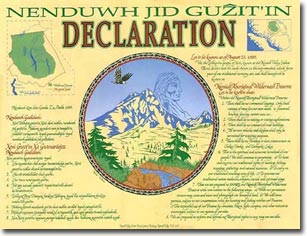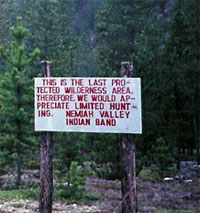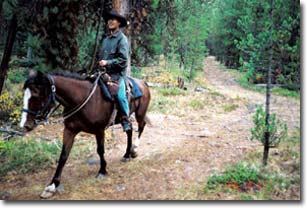A Brief History of Friends of the Nemaiah Valley
 Friends of the Nemaiah Valley (FONV) was registered as a not-for-profit society under the B.C. Societies Act in December, 2000. It was preceded by a similar society called Friends of Nemiah Valley in the late 1980’s. The earlier society was formed to assist the Xeni Gwet’in First Nations to gain control of their traditional territory in response to plans by the BC Ministry of Forests to issue cutting permits in the Brittany Triangle. One response to this threat was the issuance of the Aboriginal Wilderness Preserve Declaration on August 23, 1989.
Friends of the Nemaiah Valley (FONV) was registered as a not-for-profit society under the B.C. Societies Act in December, 2000. It was preceded by a similar society called Friends of Nemiah Valley in the late 1980’s. The earlier society was formed to assist the Xeni Gwet’in First Nations to gain control of their traditional territory in response to plans by the BC Ministry of Forests to issue cutting permits in the Brittany Triangle. One response to this threat was the issuance of the Aboriginal Wilderness Preserve Declaration on August 23, 1989.In October, 2000, we became aware of imminent Ministry of Forests plans to issue new cutting permits in the Brittany Triangle. These would result in some of the largest clear cuts in the province in this pristine wilderness, home to grizzly bears, wolves, moose and wild horses who had roamed there for over two hundred years. We met with Chief Roger William of the Xeni Gwet’in First Nations Government and their lawyer, Jack Woodward, to get details of the ongoing case for rights and title. It soon became obvious to us that the people of Xeni, through an inspired leadership, and under the guidance of wise elders, were the strongest defenders we could hope to meet of the land and its wild inhabitants.
 We decided to create Friends of the Nemaiah Valley, with a mandate to protect the environment of the Nemiah Valley and area in the spirit of the Aboriginal Wilderness Preserve. Consequently we entered into a Protocol Agreement with the Xeni Gwet’in FNG.
We decided to create Friends of the Nemaiah Valley, with a mandate to protect the environment of the Nemiah Valley and area in the spirit of the Aboriginal Wilderness Preserve. Consequently we entered into a Protocol Agreement with the Xeni Gwet’in FNG.In the spring of 2001, we hired McCrory Wildlife Services to undertake a wildlife assessment of the Brittany Triangle. Prior to this, there had been no scientific inventory of this area. The Preliminary Wildlife Assessment of the Rainshadow Wild Horse Ecosystem was completed in the spring of 2002. At a meeting and banquet in the Nemiah Valley Band Office, June 6, 2002, we presented the McCrory Report and its recommendations. Primary among these recommendations was that the Brittany Triangle become Canada’s first and only mainland wild horse preserve. The same day the Xeni Gwet’in First Nations Government issued the “?Elegesi Qiyus Wild Horse Preserve” Declaration, thus making the entire Aboriginal Wilderness Preserve also a wild horse preserve.
Public education takes the form of the publication and dissemination of original research material like the foregoing, of course. It also requires media coverage of the work we do so that the public becomes aware of it. To this end we have helped in the production of the Discovery Channel film by Summerhill Entertainment, Last of the Wild Mustangs, and of a forthcoming CBC documentary by Omni Productions out of Vancouver. We have also successfully publicized the Xeni Gwet’in FNG rights and title case and promoted the protection of the wilderness preserve and wild horse preserves through the local, provincial and national media.
 We are an all-volunteer society with patrons and supporting organizations far beyond the Nemiah Valley and outside the borders of our home province. There are now few who have not heard of the wild horses (a “national treasure”) of the Brittany Triangle and the Nemiah Valley and of the Xeni Gwet’in FNG struggle to protect their homeland.
We are an all-volunteer society with patrons and supporting organizations far beyond the Nemiah Valley and outside the borders of our home province. There are now few who have not heard of the wild horses (a “national treasure”) of the Brittany Triangle and the Nemiah Valley and of the Xeni Gwet’in FNG struggle to protect their homeland.